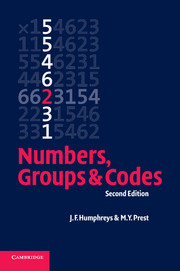Book contents
- Frontmatter
- Contents
- Preface to first edition
- Preface to second edition
- Introduction
- Advice to the reader
- 1 Number theory
- 2 Sets, functions and relations
- 3 Logic and mathematical argument
- 4 Examples of groups
- 5 Group theory and error-correcting codes
- 6 Polynomials
- Appendix on complex numbers
- Answers
- References and further reading
- Biography
- Name index
- Subject index
4 - Examples of groups
Published online by Cambridge University Press: 05 September 2012
- Frontmatter
- Contents
- Preface to first edition
- Preface to second edition
- Introduction
- Advice to the reader
- 1 Number theory
- 2 Sets, functions and relations
- 3 Logic and mathematical argument
- 4 Examples of groups
- 5 Group theory and error-correcting codes
- 6 Polynomials
- Appendix on complex numbers
- Answers
- References and further reading
- Biography
- Name index
- Subject index
Summary
The mathematical concept of a group unifies many apparently disparate ideas. It is an abstraction of essential mathematical content from particular situations. Abstract group theory is the study of this essential content. There are several advantages to working at this level of generality. First, any result obtained at this level may be applied to many different situations, and so the result does not have to be worked out or rediscovered in each particular context. Futhermore, it is often easier to discover facts when working at this abstract level since one has shorn away details which, though perhaps pertinent at some level of analysis, are irrelevant to the broad picture.
Of course, to work effectively in the abstract one has to develop some intuition at this level. Although some people can develop this intuition by working only with abstract concepts, most people need to combine such work with the detailed study of particular examples, in order to build up an effective understanding.
That is why we have deferred the formal definition of a group until the third section of this fourth chapter. For you will see that you have already encountered examples of groups in Chapter 1, so, when you come to the definition of a group in Section 4.3, you will be able to interpret the various definitions and theorems which follow that in terms of the examples that you know.
- Type
- Chapter
- Information
- Numbers, Groups and Codes , pp. 147 - 199Publisher: Cambridge University PressPrint publication year: 2004



